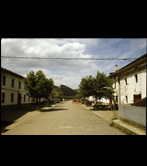The workers’ colony at the Fandería Iron Foundry
At the beginning of 1774, initiated by its owner the Duke of Granada de Ega, the forge in the Zestoa municipal area was converted into an iron foundry. It had a contract with the State to produce iron flasks to transport mercury imported from American mines. When the politician and geographer Pascual Madoz visited it in 1842, it was employing 50 men for five months of the year.
As a result, a workers colony, or a set of residential buildings, was built, the first of its type in Gipuzkoa. The colony comprises 14 houses lined along both sides of the street, along with a slightly different house for the administrator, and some communal buildings such as a hermitage and a wash house.
The houses are built in the style of the Basque caserío (rural homestead) joined by median walls. The ground floor housed agricultural tools and equipment, with living quarters upstairs. The foundry workers rented these houses, each of which had its own plot of land for cultivation.
When the contract with the State ran out of 1944, the Iraeta foundry had to change production and began manufacturing tin. After 1855 it changed its name to “Fábrica de Hierro de Vera-Iraeta” and extended its activities to the old forges of Vera de Bidasoa (Bera, Navarra).



